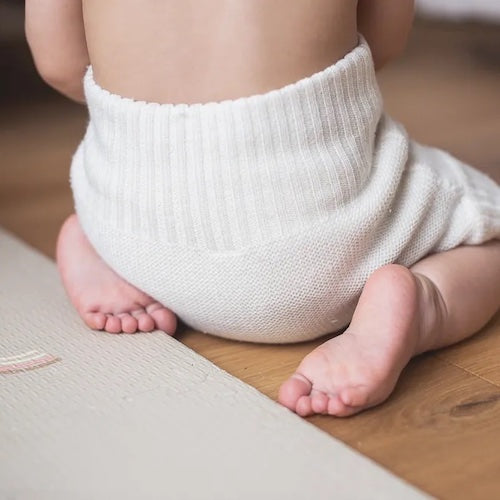Using merino wool isn't as hard as you think - use our 5-minute guide
Posted by MAJALIWA BASS

Whether you're new to cloth diapering or been at it for awhile, chances are you've heard one of these terms - woolie, longie, or soaker. Using wool with your cloth diapers is very easy and in this article I explain how.
In this post I'll cover questions like...
- What is a wool soaker?
- Are wool diaper covers worth it?
- How do you Lanolize wool?
- How do you clean a wool soaker?
- What are the best wool diaper covers?
- How do you use wool diaper covers?
- What is the best lanolin for wool diapers?
- How to get poop out of wool?
- What fabric is best for wool diaper covers?
- What are the benefits of wool diaper covers?
- How many wool diaper covers do you need?
- Can I use a wool cover over a disposable diaper?
- How do you treat wool diaper covers?
- How do you stop a wool cover from leaking?
- My promise to you
I am a mom of four that had the "privilege" of diapering 4 babies (2 boys and 2 girls) - and that came with a lot of mistakes and lessons learned. So in this blog I share the diapering tips and strategies that worked really well for me. My hope is that these tips make your diaper journey super easy - so that you can spend less time online reading articles like this, and more time on the things that matter most - like your sweet little one. So let’s dive in!
- Quick answers
I would love for you to read this full blog, but if you just want to cut to the chase, here’s the quick answers to the questions that are top of mind for you.
- What is a wool soaker? Also called longies, woolies, and shorties - Wool soakers are diaper covers made from 100% wool (usually Merino wool) - designed to be worn over Flat, Fitted, Prefold and Contour cloth diapers, and nighttime disposable diapers.
- Are wool diaper covers worth it? Yes. While pricey at first, you only need 2 to 3 for an entire cloth diaper stash. In between uses, you lay them flat to air out and dry.
- How do you Lanolize a wool soaker? Dissolve 1 tbsp of lanolin and 3 drops of baby shampoo in 1 cup of boiling hot water. Add mixture to a sink half-way filled with lukewarm water. Add your wool item and let it soak for 30 minutes. Remove and lay flat on a towel dry.
- How do you clean a wool soaker? Rinse under cool running water, then lanolize.
- What are the best wool diaper covers? Disana, Pooters, and Truly Charis
- How do you use wool diaper covers? Lanolize once a month and place over any cloth diaper. In between uses, lay flat to air dry.
- What is the best lanolin for wool diapers? Lansinoh IMO
- How do you get poop out of wool? Rinse under cool running water.
- What fabric is best for wool diaper covers? 100% Merino Wool
- What are the benefits of wool diaper covers? They are easy to use, absorbent, breathable, waterproof, extremely soft, and naturally antibacterial - making them perfect for heavy wetters and babies with sensitive skin.
- How many wool diaper covers do you need? 2 to 3
- Can I use a wool cover over a disposable diaper to prevent leaks? Yes
- How do you treat wool diaper covers? Hand wash and lanolize once a month, and air dry.
- How do you stop a wool cover from leaking? If it's leaking the lanolin is either gone, or not fully covering the wool item. Rinsing and lanolizing will restore the waterproofness.
WHAT ARE WOOL SOAKERS?
Wool soakers (also called longies, woolies, shorties and soakers) are diaper covers made from 100% wool designed to be worn over Flat, Fitted, Prefold and Contour cloth diapers. Wool soakers are typically made from Angora or Merino wool and are extremely soft, breathable, and naturally antibacterial. The beauty of wool soakers is that they can absorb up to one-third of their own weight in water, they're naturally antibacterial and they breathe extremely well so they can be worn in both warm and cold months. For this reason they are great for use during both day and night.
HOW DO WOOL SOAKERS WORK?
When the diaper becomes wet, the wool soaker wicks the moisture away from the diaper by absorbing it. Lanolin, a natural oil that comes from sheep, keeps the urine from leaking back out of the wool quickly. Over time, the lanolin needs to be replaced (roughly every 2 to 3 weeks) to help the wool soaker maintain its super absorbent abilities. This is done through a process called lanolizing. Lanolizing cleans the wool and restores the lanolin to the cover.
In between use, air out your wool soaker by laying it flat. This will allow the cover to dry and will eliminate any odors that may be in the wool cover. If poop gets on the diaper cover, you will need to clean and lanolize immediately.
Click here to watch a short step-by-step video on how to wash and lanolize your wool >>
ALTERNATIVES
A cheaper option to wool soakers are fleece covers. Like wool soakers, fleece covers are meant to be worn over Flat, Fitted, Prefold and Contour diapers. Unlike wool however, fleece covers don’t breathe as well making them great for colder months, but aren't recommended for use during warmer months as they would make baby hot. The upsides to fleece covers however are that they are not as expensive as wool soakers and they don't require a special cleaning process (i.e. they can be thrown in the wash with your other diapers).
For more info on Fleece covers, see Caring for Fleece.
RECOMMENDED BRANDS
There are a ton of wool cover brands out there. Listed below are the most commonly purchased wool brands. If you're the DIY (do-it-yourself) type, you can also try your hand at either knitting your own wool or sewing your own wool covers from upcycled wool sweaters. Below are a few DIY resources too.
Popular Wool Brands
- Disana
- Truly Charis
- Pooters
DIY wool soaker tutorials
- Sprightly Soaker Pattern by Little Comet Tails
- Katrina's Sew Quick Soaker Patterns
- Sweet Baby Soakers and Skirties
WHAT TO BUY
- Wool Covers - if you plan on using wool full-time, you'll need 4 to 6 wool longies for colder months and another 4 to 6 wool shorties for warmer months. If you only plan on only using wool for nighttime use, you'll only need 2 to 3 covers.
- Lanolin - we recommend this
- Soap - either baby wash, wool wash, or castille soap - we recommend this
WASHING & LANOLIZING WOOL
If you've purchased a wool cover to use with your cloth diapers, then you'll need to lanolize it to make it "water proof". Below are simple instructions for lanolizing your wool.
Note: you will need to do this every 2 to 3 weeks, if your wool gets stinky, or when your wool starts to leak.
What You’ll Need:
- 1 Tbsp of Lanolin (we recommend Lansinoh Breast Cream)
- 3 drops of baby wash, wool wash or castille soap
- 1 cup of boiling hot water
- Towel
Instructions:
- Rinse wool cover under cool running water to remove urine and/or feces
- Boil 1 cup of water
- Add 1 tbsp of lanolin and stir well
- Add 3 drops of baby wash, wool wash or castille soap
- Stir well until completely blended
- Fill a sink or bowl with lukewarm water (enough to barely cover your wool)
- Add your lanolin mixture to the sink or bowl
- Add your wool item and let it soak for 30 minutes
- Remove your wool and gently squeeze it to remove excess water
- Lay flat on your towel
- Roll the towel up, gently squeezing it as you go
- Unroll the towel and lay your wool flat to dry (takes up to 48 hours)
Note: Never dry wool in the dryer and never use Woolite.
HOW TO STORE WOOL
When stored over a period of time, wool has a propensity to be eaten by a number of insects - mainly moths and carpet beetles. They're attracted to the protein in the wool fiber. To keep insects from eating your wool, follow these simple steps:
- clean your wool
- wrap it in newspaper (moths hate newspaper)
- place it in a cotton pillowcase (or other cotton bag)
- tie the end of the bag shut with twine
- place bag inside of another pillowcase with the tied ends on opposite sides
- keep away from direct sunlight, damp areas, hot attics or dusty garages
Do NOT store your wool in a cardboard box, plastic bag or plastic bin. This will cause mold and mildew damage. Also, keep away from direct sunlight, damp areas, hot attics.
HOW TO REPAIR WOOL IF IT SHRINKS
Washing wool in hot water or (in my case) if your wool got accidentally tossed in the washing machine and then the dryer (ouch!) then your wool cover has shrunken and tightened quit a bit. Follow these steps to loosen up your wool so you can use it again.
- Fill your sink with lukewarm water
- Add 7 to 10 ounces of hair conditioner
- Add your wool and let it soak for about 20 minutes
- Then gently stretch it back to the right size/shape
- Mix 2 tablespoons of vinegar with 1 gallon of lukewarm water in a large bowl
- Add your wool to the vinegar solution and swish gently to remove the conditioner
- Hand wash and lanolize your wool using your usual wool wash routine
- Lay flat to dry



